Page 274 of 481
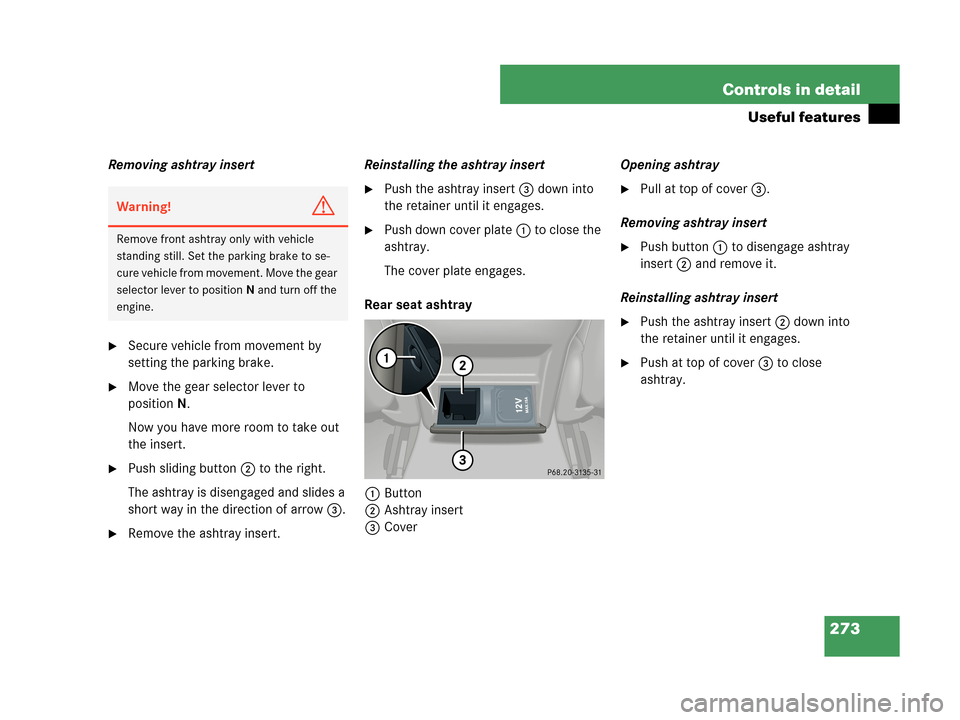
273 Controls in detail
Useful features
Removing ashtray insert
�Secure vehicle from movement by
setting the parking brake.
�Move the gear selector lever to
positionN.
Now you have more room to take out
the insert.
�Push sliding button2 to the right.
The ashtray is disengaged and slides a
short way in the direction of arrow3.
�Remove the ashtray insert.Reinstalling the ashtray insert
�Push the ashtray insert 3 down into
the retainer until it engages.
�Push down cover plate 1 to close the
ashtray.
The cover plate engages.
Rear seat ashtray
1Button
2Ashtray insert
3CoverOpening ashtray
�Pull at top of cover3.
Removing ashtray insert
�Push button1 to disengage ashtray
insert2 and remove it.
Reinstalling ashtray insert
�Push the ashtray insert2 down into
the retainer until it engages.
�Push at top of cover3 to close
ashtray.
Warning!G
Remove front ashtray only with vehicle
standing still. Set the parking brake to se-
cure vehicle from movement. Move the gear
selector lever to positionN and turn off the
engine.
Page 293 of 481

292 Operation
In the “Operation” section you will find
detailed information on operating,
maintaining and caring for your vehicle.
The first 1 000 miles (1 500 km)
The more cautiously you treat your vehicle
during the break-in period, the more satis-
fied you will be with its performance later
on.
�Drive your vehicle during the first
1 000 miles (1 500 km) at varying but
moderate vehicle and engine speeds.
�During this period, avoid heavy loads
(full throttle driving) and excessive
engine speeds (no more than
2/3 of
maximum rpm in each gear).
�Shift gears in a timely manner.
�Avoid accelerating by kickdown.
�Do not attempt to slow the vehicle
down by shifting to a lower gear using
the gear selector lever.
�Select positions3,2or1 only when
driving at moderate speeds (for hill
driving).
�Select modeC as the preferred shift
program (
�page 174) for the first
1 000 miles (1 500 km).After 1 000 miles (1 500 km), you may
gradually increase vehicle and engine
speeds to the permissible maximum.
All of the above instructions, as may apply
to your vehicle type, also apply when
driving the first 1 000 miles (1 500 km)
after the engine or the rear differential has
been replaced.
iAlways obey applicable speed limits.
Page 297 of 481
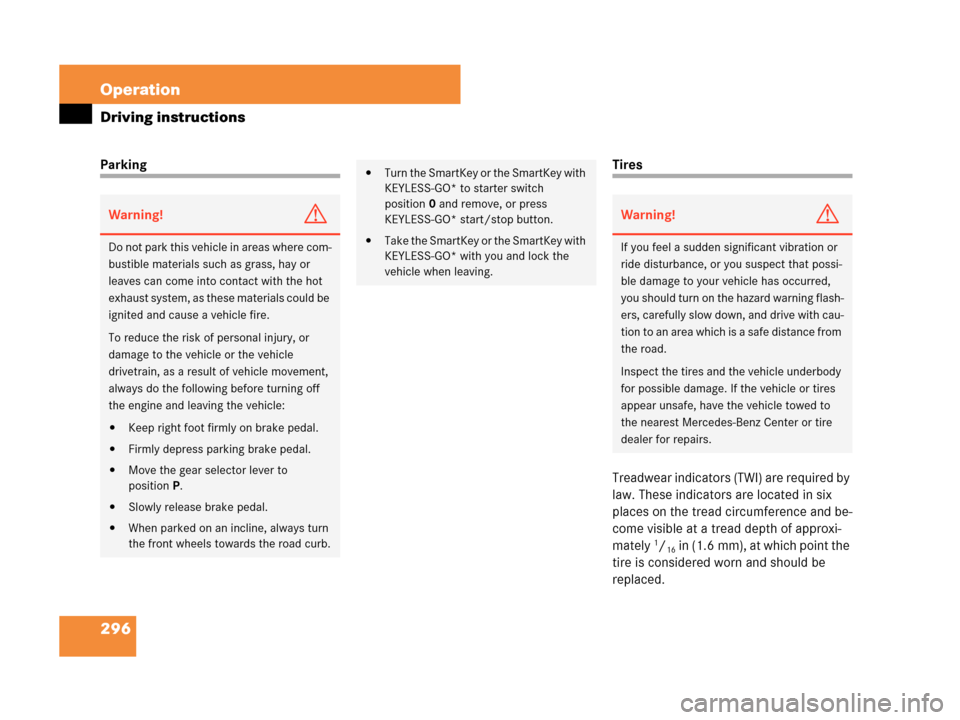
296 Operation
Driving instructions
ParkingTires
Treadwear indicators (TWI) are required by
law. These indicators are located in six
places on the tread circumference and be-
come visible at a tread depth of approxi-
mately
1/16 in (1.6 mm), at which point the
tire is considered worn and should be
replaced.
Warning!G
Do not park this vehicle in areas where com-
bustible materials such as grass, hay or
leaves can come into contact with the hot
exhaust system, as these materials could be
ignited and cause a vehicle fire.
To reduce the risk of personal injury, or
damage to the vehicle or the vehicle
drivetrain, as a result of vehicle movement,
always do the following before turning off
the engine and leaving the vehicle:
�Keep right foot firmly on brake pedal.
�Firmly depress parking brake pedal.
�Move the gear selector lever to
positionP.
�Slowly release brake pedal.
�When parked on an incline, always turn
the front wheels towards the road curb.
�Turn the SmartKey or the SmartKey with
KEYLESS-GO* to starter switch
position0 and remove, or press
KEYLESS-GO* start/stop button.
�Take the SmartKey or the SmartKey with
KEYLESS-GO* with you and lock the
vehicle when leaving.
Warning!G
If you feel a sudden significant vibration or
ride disturbance, or you suspect that possi-
ble damage to your vehicle has occurred,
you should turn on the hazard warning flash-
ers, carefully slow down, and drive with cau-
tion to an area which is a safe distance from
the road.
Inspect the tires and the vehicle underbody
for possible damage. If the vehicle or tires
appear unsafe, have the vehicle towed to
the nearest Mercedes-Benz Center or tire
dealer for repairs.
Page 300 of 481
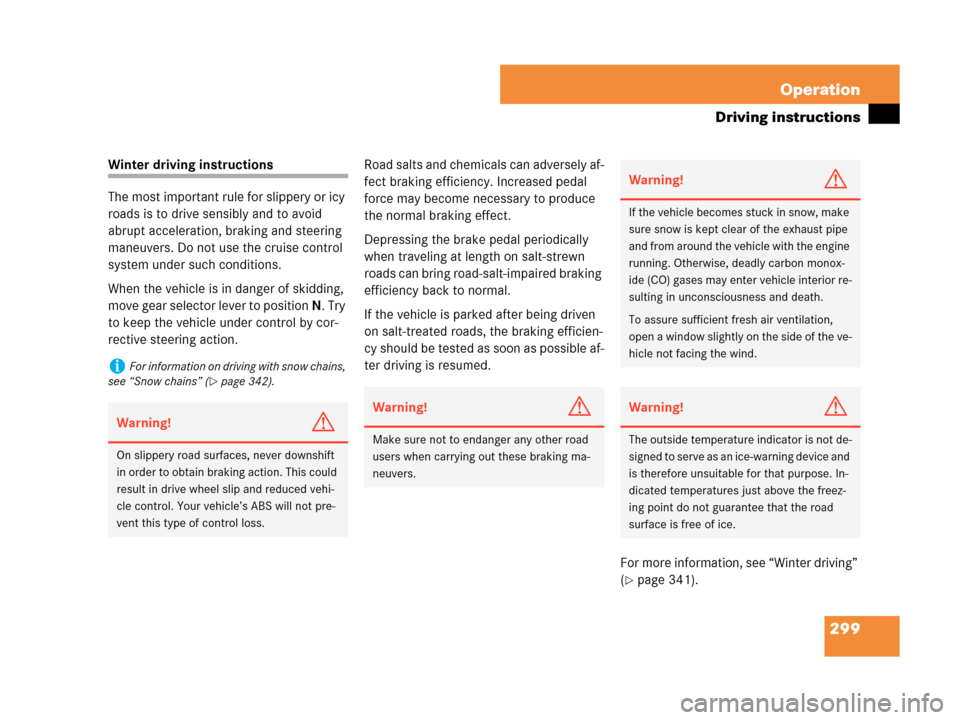
299 Operation
Driving instructions
Winter driving instructions
The most important rule for slippery or icy
roads is to drive sensibly and to avoid
abrupt acceleration, braking and steering
maneuvers. Do not use the cruise control
system under such conditions.
When the vehicle is in danger of skidding,
move gear selector lever to position N. Try
to keep the vehicle under control by cor-
rective steering action.Road salts and chemicals can adversely af-
fect braking efficiency. Increased pedal
force may become necessary to produce
the normal braking effect.
Depressing the brake pedal periodically
when traveling at length on salt-strewn
roads can bring road-salt-impaired braking
efficiency back to normal.
If the vehicle is parked after being driven
on salt-treated roads, the braking efficien-
cy should be tested as soon as possible af-
ter driving is resumed.
For more information, see “Winter driving”
(
�page 341).
iFor information on driving with snow chains,
see “Snow chains” (
�page 342).
Warning!G
On slippery road surfaces, never downshift
in order to obtain braking action. This could
result in drive wheel slip and reduced vehi-
cle control. Your vehicle’s ABS will not pre-
vent this type of control loss.
Warning!G
Make sure not to endanger any other road
users when carrying out these braking ma-
neuvers.
Warning!G
If the vehicle becomes stuck in snow, make
sure snow is kept clear of the exhaust pipe
and from around the vehicle with the engine
running. Otherwise, deadly carbon monox-
ide (CO) gases may enter vehicle interior re-
sulting in unconsciousness and death.
To assure sufficient fresh air ventilation,
open a window slightly on the side of the ve-
hicle not facing the wind.
Warning!G
The outside temperature indicator is not de-
signed to serve as an ice-warning device and
is therefore unsuitable for that purpose. In-
dicated temperatures just above the freez-
ing point do not guarantee that the road
surface is free of ice.
Page 354 of 481
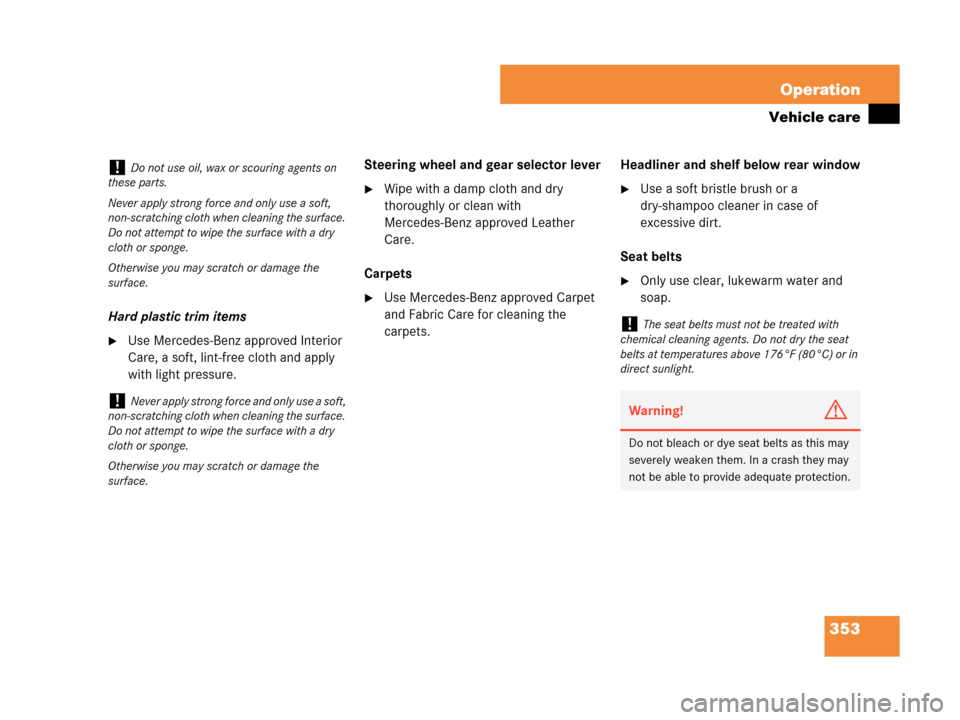
353 Operation
Vehicle care
Hard plastic trim items
�Use Mercedes-Benz approved Interior
Care, a soft, lint-free cloth and apply
with light pressure.Steering wheel and gear selector lever
�Wipe with a damp cloth and dry
thoroughly or clean with
Mercedes-Benz approved Leather
Care.
Carpets
�Use Mercedes-Benz approved Carpet
and Fabric Care for cleaning the
carpets.Headliner and shelf below rear window
�Use a soft bristle brush or a
dry-shampoo cleaner in case of
excessive dirt.
Seat belts
�Only use clear, lukewarm water and
soap.
!Do not use oil, wax or scouring agents on
these parts.
Never apply strong force and only use a soft,
non-scratching cloth when cleaning the surface.
Do not attempt to wipe the surface with a dry
cloth or sponge.
Otherwise you may scratch or damage the
surface.
!Never apply strong force and only use a soft,
non-scratching cloth when cleaning the surface.
Do not attempt to wipe the surface with a dry
cloth or sponge.
Otherwise you may scratch or damage the
surface.
!The seat belts must not be treated with
chemical cleaning agents. Do not dry the seat
belts at temperatures above 176°F (80°C) or in
direct sunlight.
Warning!G
Do not bleach or dye seat belts as this may
severely weaken them. In a crash they may
not be able to provide adequate protection.
Page 377 of 481
376 Practical hints
What to do if …?
Display messagePossible cause/consequencePossible solution
PSelector lever
in ParkYou have turned off the engine with the
KEYLESS-GO* start/stop button in gear
selector lever positionN and opened the
driver’s door.
or
You have attempted to switch off the en-
gine with the KEYLESS-GO* start/stop
button while the gear selector lever was in
positionR orD.�Place the gear selector lever in
positionP.
Please
shift to
N or PYou have attempted to start the engine
with the KEYLESS-GO* start/stop button
while the gear selector lever was in
positionR orD.�Place the gear selector lever in
positionP or N.
Page 402 of 481
401 Practical hints
Unlocking/locking in an emergency
1Locking
�Insert the mechanical key into the
driver’s door lock until it stops.
�Turn the mechanical key clockwise to
position1.
The driver’s door is locked.Manually unlocking the gear selector
lever
In case of power failure, the gear selector
lever can be manually unlocked, e.g. to tow
the vehicle.
1Tab
2tool (e.g. flat blade screwdriver)
�Pull the tab1 of the covering back in
direction of the center armrest com-
partment.
�Insert a tool2 (e.g. flat blade screw-
driver) into the opening.
�Perform the following two steps simul-
taneously:
�Push tool2 down- and forward in
the direction of the arrow.
�Move gear selector lever from
positionP.
�Remove the tool2 from the opening.
�Push the tab1 of the covering back.
iThis procedure does not arm the anti-theft
alarm system, nor does it lock the fuel filler flap.
iThe gear selector lever is locked again when
moving it to positionP.
Page 416 of 481
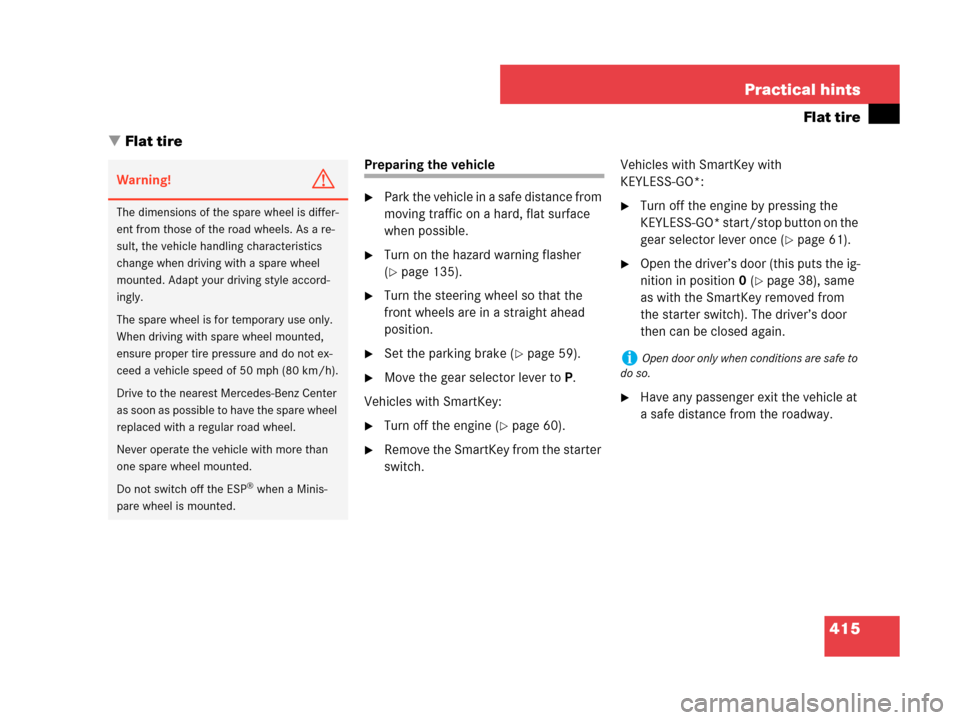
415 Practical hints
Flat tire
�Flat tire
Preparing the vehicle
�Park the vehicle in a safe distance from
moving traffic on a hard, flat surface
when possible.
�Turn on the hazard warning flasher
(
�page 135).
�Turn the steering wheel so that the
front wheels are in a straight ahead
position.
�Set the parking brake (�page 59).
�Move the gear selector lever toP.
Vehicles with SmartKey:
�Turn off the engine (�page 60).
�Remove the SmartKey from the starter
switch.Vehicles with SmartKey with
KEYLESS-GO*:
�Turn off the engine by pressing the
KEYLESS-GO* start/stop button on the
gear selector lever once (
�page 61).
�Open the driver’s door (this puts the ig-
nition in position0 (
�page 38), same
as with the SmartKey removed from
the starter switch). The driver’s door
then can be closed again.
�Have any passenger exit the vehicle at
a safe distance from the roadway.
Warning!G
The dimensions of the spare wheel is differ-
ent from those of the road wheels. As a re-
sult, the vehicle handling characteristics
change when driving with a spare wheel
mounted. Adapt your driving style accord-
ingly.
The spare wheel is for temporary use only.
When driving with spare wheel mounted,
ensure proper tire pressure and do not ex-
ceed a vehicle speed of 50 mph (80 km/h).
Drive to the nearest Mercedes-Benz Center
as soon as possible to have the spare wheel
replaced with a regular road wheel.
Never operate the vehicle with more than
one spare wheel mounted.
Do not switch off the ESP
® when a Minis-
pare wheel is mounted.
iOpen door only when conditions are safe to
do so.